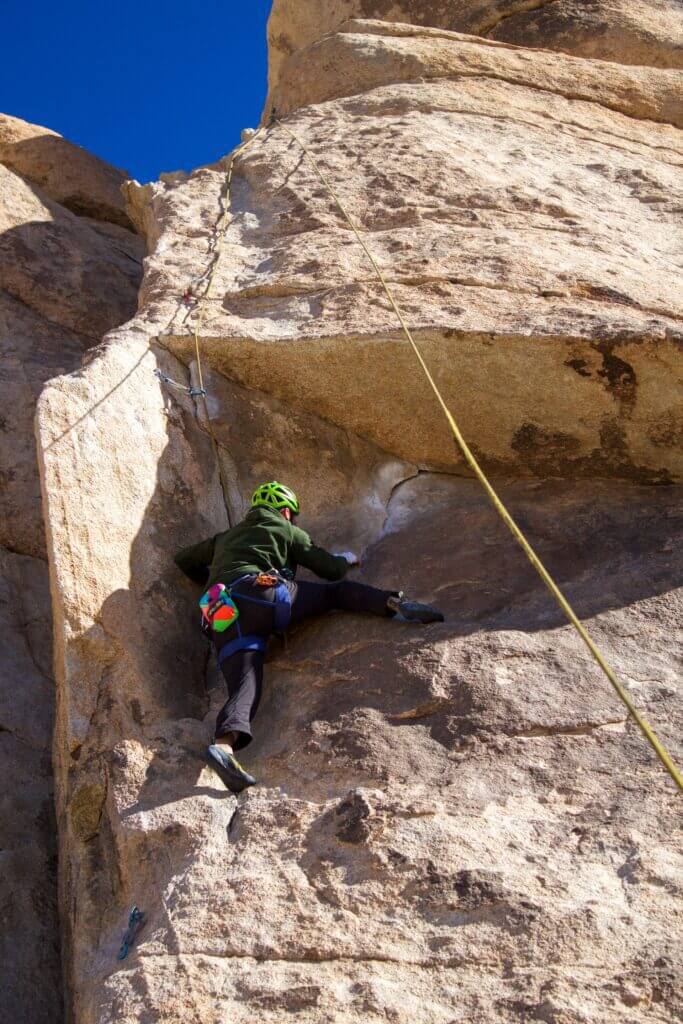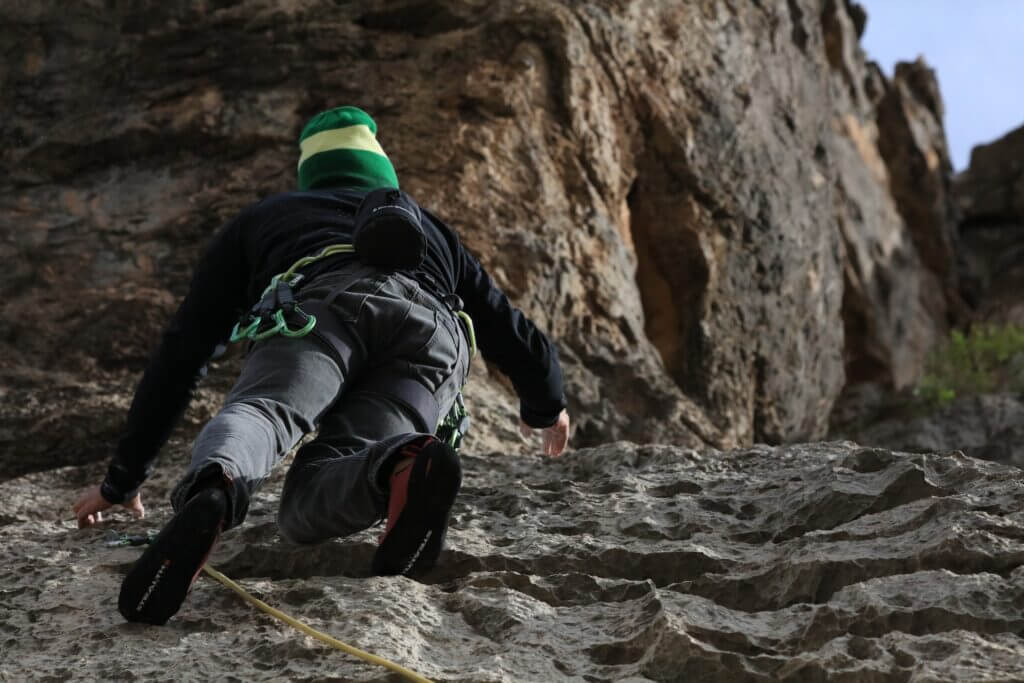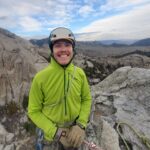The term “rock climbing” can be a bit misleading. It makes the sport sound like a singular activity. When in reality, rock climbing has many different styles. Not including some niche examples of climbing, most climbers would agree that the three most popular styles of climbing are– bouldering, traditional climbing, and sport climbing.
Of the three, I would argue that sport climbing is the most well-known. Sport climbing is where you ascend a single- or multi-pitch route, protecting yourself by clipping your rope into fixed bolts and anchors drilled into the rock, all the while being belayed by your partner.
Keep reading to learn about sport climbing, what separates it from traditional climbing, and for guidance on how to get started.
Sport vs. Trad Climbing
Traditionally, climbers would place protection equipment into cracks in the wall to protect themselves. This style of climbing is called traditional or trad climbing.
Sport climbing is a newer style first popularized in the 1980s. Sport climbers rely on protection bolts permanently drilled into the rock to protect themselves in the event of a fall instead of trad gear.
With protection bolts, climbers could unlock large swathes of rock that had previously gone unclimbed because they did have cracks for trad gear.
Due to the “permanent” nature of bolts, sport climbing is often understood as less committing and less risky. However, to be clear– sport climbing, like all forms of climbing, is inherently dangerous.
Sport climbing is also considered more accessible than trad climbing because the expertise required to operate the equipment, i.e., quickdraws, is much less involved. However, that is not to say that sport climbing is easy. Because of modern climbing technology and bolting techniques, sport climbers continue to evolve the sport with incredibly difficult first ascents.

Lead Climbing vs. Top Roping
When you go sport climbing, you will either be partaking in lead climbing or top roping.
The term leading climbing comes from someone taking the lead, or going first, also known as the lead climber or leader. Lead climbing is when you tie into the climbing rope and bring it up the climb with you, periodically clipping the rope into protection bolts along the way in case you fall.
When a lead climber reaches the top of a sport climb, they clip their rope into an anchor they build themselves or into the fixed anchor. Then they can be lowered by their belayer or rappel down themselves.
On the other hand, top roping is when you tie into the climbing rope that is already secured in the anchor at the top of the climb, hence the name, top roping.
Building or threading prebuilt anchors and dropping a rope on a climb to make a top rope can be accomplished from the top of the cliff. However, as I just mentioned, the lead climber who goes first can also set up the top rope by lead climbing.
The risks involved with lead climbing are more significant than top roping because the leader is at risk of taking more significant falls, some of which could result in a ground fall if the leader doesn’t adequately protect themselves or if the belayer makes a mistake.
On the other hand, top roping falls are drastically less severe. Although sometimes they do result in a pendulum swing that could cause safety issues.
The Essential Gear
Compared to trad climbing, the list of essential gear for sport climbing is shorter. But then again, compared to bouldering, sport climbing requires quite a lot.
The following list of items is what I consider essential to be an autonomous sport climber. But of course, you can climb with friends and get away with having a lot less (wondering what you need to wear?).
- Helmet
- Harness
- Climbing shoes
- Chalk bag
- Rope
- Quickdraws
- Belay device
- Backpack
Optional Accessories
The items I mentioned above are essential for going sport climbing autonomously. The following items are optional accessories that are not mandatory but that improve your experience while sport climbing.
- Belay gloves
- Belay glasses
- Climbing tape

Climbing Terminology
If you are new to climbing, you might have felt like the conversations you overheard in the gym or at the crag were from another language. They could have been if you lived in a diverse metropolitan area or were climbing in a well-known destination.
However, the chances are you were hearing distinct climbing slang and terminology you haven’t mastered yet. Below is a short glossary of terms to jump-start your climbing vocabulary.
- Beta – advice that another climber provides that assists you in some way, such as how to climb the crux or where the good holds are.
- On-Sight – when you successfully climb a route first try from the ground without seeing it before or receiving beta.
- Redpoint – when you successfully send a route from the ground after working out the moves and perfecting it.
- Whip – a significant fall, also referred to as a whipper, a lead climber takes when they are well above their last piece of protection.
- Spraying – providing unsolicited advice (beta) to another climber who does not want your assistance.
- Cleaning – when you remove all the quickdraws from the bolts so you can reuse them on a different climb.
Climbing Crag Etiquette
Proper etiquette comes with everything in life. For example, there are proper ways to drive a car and move around busy public areas. The same goes for sport climbing. So before you head to the crag, ensure you’re up-to-date on climbing crag etiquette.
- Monitor your volume. Try hard noises, and communicating with your climbing partner is acceptable. However, loud music and raucous behaviour are usually frowned upon.
- Pack it in, pack it out. Everything you bring with you, including your trash, food scraps, and bits of climbing tape, must also leave with you.
- Avoid creating a yard sale. Sport climbing crags are shared, some of which have limited space, so mitigate the extent to which your equipment spreads out throughout the crag like a yard sale.
- Play nice with others. Simple etiquette like waiting your turn, communicating respectfully, and sharing goes a long way toward a pleasant day out.
Sport Climbing at the Olympics
The sport of rock climbing has exploded in popularity over the past five years. As a result, climbing is now an Olympic Sport. Sport climbing debuted in the 2020 Olympics in Tokyo (which took place in 2021 because of the COVID-19 pandemic).
In Tokyo, climbing athletes competed in a combined format, including sport climbing, bouldering, and speed climbing. However, for the 2024 Olympics in Paris, athletes can compete in a sport and bouldering combined event or separately in speed climbing.



